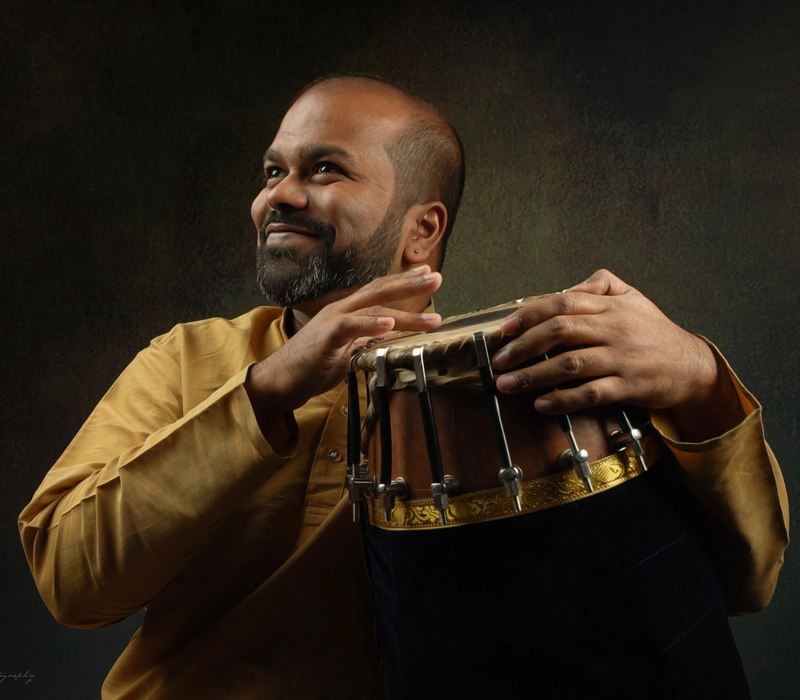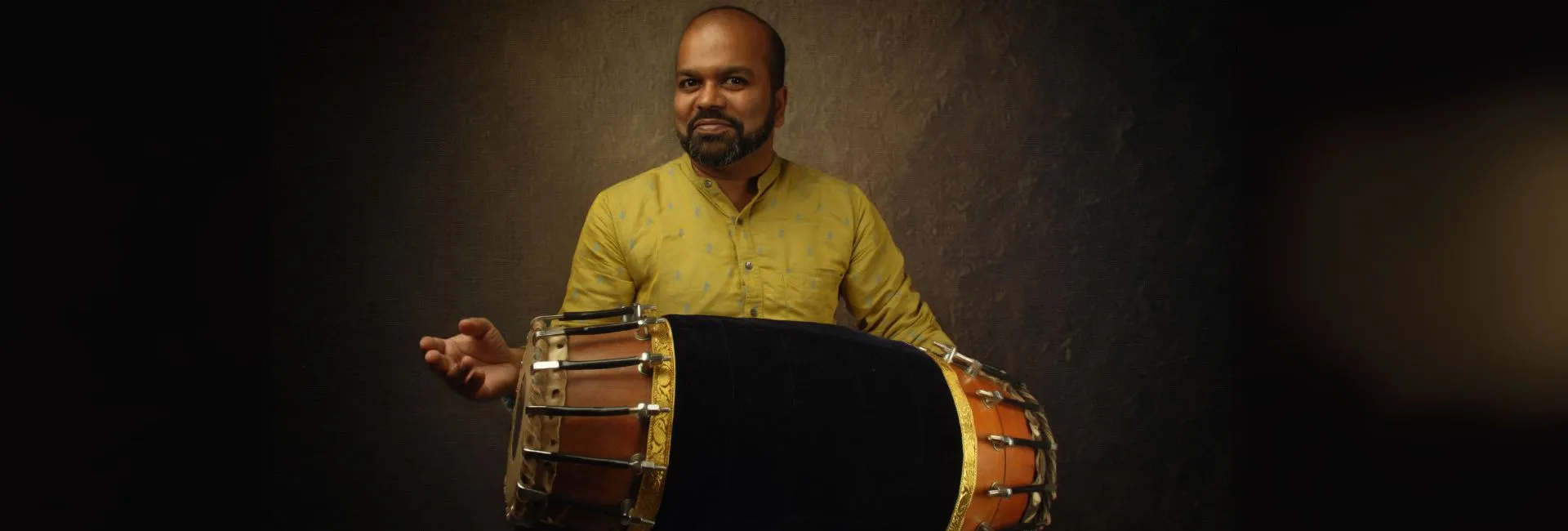(June 9, 2025) Balakumar Paramalingam didn’t just learn Carnatic rhythm — he lives it. A mridangam artist raised between Sri Lanka, India, and France, he now calls Paris home, where tradition meets innovation in his hands. As a professor at the Royal Conservatory of Brussels, he teaches and helps students develop fluency and improvisational skills, all while bridging South Indian rhythmic traditions with global music. From introducing konnakol to European classrooms to performing with jazz ensembles and electronic artists, Balakumar is part of a growing wave taking Indian classical music beyond its borders. In this Global Indian conversation, he shares how music chose him—and how he’s using it to build cross-cultural connections, one beat at a time.

A Childhood Tuned to Tradition
When he was just five years old, Paramalingam heard his father play the mridangam in his living room. It was a memory that is etched deep, as he says this was the exact moment when the power of music struck him. “The way his fingers shaped rhythm, the way the air vibrated with each stroke—it was a revelation. Not just a performance, but a form of devotion. That moment planted the seed in my musical journey,” he says. His father was not only a passionate percussionist but also an avid collector of recordings and had every available live concert of the legendary Palani Subramania Pillai and would often recount having witnessed his performances. “He introduced me to the great masters, Trichy Sankaran, Palghat Mani Iyer, and of course, the extraordinary violinist Dr L. Subramaniam, whose musical voice stirred something in me early on. My father ensured I didn’t just listen but absorbed,” he reminisces.
This meant that by 14, he was already performing in public, learning the difficult art of accompaniment. “My father insisted I understand the soul of the mridangam, not just how to play, but how to make it speak. He placed immense importance on nādham, the quality and clarity of sound—and so, shaping beautiful sound became my first aesthetic challenge,” he explains.
From Inheritance to Identity
Moving from Sri Lanka to India and then France (when he was nine years old), his training took a new direction when he began learning under Karaikudi R. Krishnamurthy in London. But it was with A. S. Ranganathan, his mentor with whom he trained for over 20 years, that he truly began to understand the beauty of restraint, of architecture, of the silent grammar behind rhythm, and of the aesthetical aspect of the mridangam. “With him, I didn’t just learn solkattu and compositions; I learnt taste, timing, and the narrative power of percussion. I continue this path today under his guru, Sangeetha Kalanidhi Trivarur Bhaktavatsalam, who’s playing bridges both virtuosity and depth,” he says.

However, it wasn’t until his father passed away that he truly felt music had become his profession. “Something shifted. I could no longer just ‘play’. I had to carry on something. His legacy, his discipline, his dreams—they became my duty. Continuing this path became a necessity, not just a choice. Music, once a beautiful inheritance, became my own story to write,” he says.
Teaching Beyond Borders
Paramalingam admits that he did not choose music, but it was the other way round – music chose him through his father, through exile, and through necessity. Over time, this necessity became a vocation, then a profession, and finally a responsibility to transmit in turn to students, to audiences, and to the next generation. Displaced by civil war, music was never a luxury or a pastime for him; rather, it was a necessity of being. In France it became their anchor, identity, and a means of continuity.
“Today, when I teach or perform, I carry with me that origin story, not as a burden but as a source of depth and authenticity, rooted in lived experience. I see rhythm not only as a musical structure but as a lifeline, one that continues to guide me beyond borders.” As a percussionist based in Paris, he inhabits a dual space, rooted in tradition and looking outside the box, performing in traditional settings, but also collaborating with jazz musicians, Western classical ensembles, and contemporary dancers. Each collaboration is a negotiation of time, breath, and silence – elements that are fundamental in both Carnatic music and global improvisational languages.
View this post on Instagram
“Parallel to performance, my life as an educator is central. At the Royal Conservatory of Brussels, I teach South Indian rhythm through the art pf konnakol in the Bachelor in Rhythms and Rhythmics (BaRR) programme. My pedagogy is grounded in vocalisation and embodied practice, allowing musicians from all backgrounds – jazz, classical, and contemporary – to develop rhythmic awareness through the lens of Carnatic thinking.” Through workshops, he has also introduced konnakol and rhythm improvisation to young audiences, amateurs, and professionals across France, Belgium, and beyond. The goal is to build bridges, not just between genres, but between different ways of perceiving rhythm and musical identity.
Where Tradition Meets Experiment
Over the years, his music has evolved from the rooted rigour of traditional mridangam training to an ever-expanding exploration of sound, texture, and dialogue across genres. “While my foundation remains deeply anchored in the Carnatic rhythmic tradition, its cycles, architecture, and grammar, I have always been curious about how rhythm can travel, how it can converse with other musical worlds,” he explains.

This curiosity led him naturally toward hybrid and cross-genre projects. A case in point is the OHM, a powerful electro-acoustic trio that blends the intricate mathematics of South Indian rhythms with the pulse of electronic music. “In OHM, the konnakol does not just accompany; it drives the beat, challenges the machine, and invites a different form of dance. For younger audiences especially, this format acts as a bridge: they enter through the familiarity of electronic textures and slowly discover the complexity and beauty of rhythmic phrasing rooted in ancient traditions,” he adds. He has also worked on collaborative projects that integrate jazz, contemporary classical, and global improvisation.
His musical journey has always been shaped by encounters across cultures, genres, and generations. “I have had the chance to collaborate with world-class musicians such as violinist Gilles Apap and bassist Dominique di Piazza, as well as jazz innovators like Stéphane Galland, cellist Vincent Ségal, and multi-percussionist Keyvan Chemirani. These encounters are not just artistic meetings, they are deep rhythmic conversations between traditions. I have performed in prestigious venues and festivals such as the Philharmonie de Paris, Bozar Brussels, Muziekgebouw Amsterdam, Musée Guimet, De Singel (Antwerp), Senghor – MuzieKpublique (Brussels), and throughout the Indian Caribbean Ocean during our Layam tour. These platforms have allowed me to explore hybrid formats—combining konnakol, mridangam, and Carnatic rhythmic structures with jazz, orchestral music, and electro-acoustic landscapes,” he adds. He works closely with his brother Senthil, a violinist and an experienced world music promoter with over 20 years of expertise in cross-cultural programming building bridges between South Asian classical forms and contemporary global scenes.

A Legacy Reimagined
Deeply influenced by maestro Dr L. Subramaniam, with whom he had the opportunity to play, he admits that it was more than a professional experience. “It has been a profound musical and human journey. From our very first rehearsal, I understood I was in the presence of someone whose artistic vision had the power to elevate everyone around him. I had the immense privilege of performing with him during his concert with the Orchestra of Normandy. That encounter was transformative. Not only was I playing with a world-class ensemble, but I was also immersed in a collaborative space where every gesture, every note from his violin, demanded that I refine my listening, anticipate my phrasing, and become one with his musical line. It wasn’t just about playing correctly; it was about achieving a kind of musical symbiosis,” he says. He believes that the past and your story are unique, and the difference is your strength. “Do not be afraid,” he says.
For Balakumar Paramalingam, rhythm is more than music—it’s memory, identity, and connection. From the living room where he first heard his father’s mridangam to concert halls and classrooms across Europe, his journey is a tribute to tradition and transformation. By blending deep-rooted Carnatic techniques with modern sounds and global collaborations, he is not only preserving a classical legacy but also reshaping it for a new generation. As both performer and teacher, Balakumar continues to honour the past while crafting a future where South Indian rhythm speaks to audiences everywhere—resonating far beyond its origin, one pulse at a time.
ALSO READ | Anokha Sound: How the Asian Underground became a voice for immigrant identity



